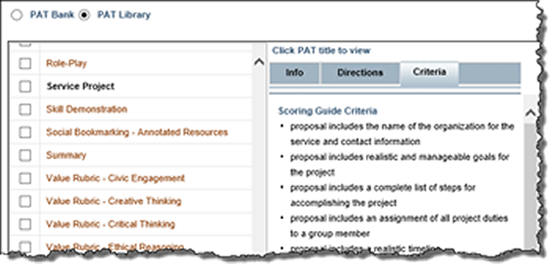Getting HIPs: High Quality Across the Curriculum
High impact educational practices (HIPs) offer the promise of retaining and graduating students prepared for success. It’s more than just a promise. Research shows that educators who use HIPs – such as internships, collaborative projects, service learning and more -- see deeper learning, improved engagement and better completion rates. Employers like them too; they want to hire people who have broad-based intellectual skills, as well as job-specific knowledge.
Aiming for Wider Reach
Still, not all is well in the world of HIPs and colleges. According to the Association of American Colleges and Universities (AAC&U), most campuses are not fully on board with H IPs: the “utilization of active learning practices is unsystematic.” In many cases, HIPs are developed by innovative instructors and are not based on any college-wide vision or goal. At a given college, some learners may benefit from HIPs, but their peers may have no HIPs opportunities. Worse yet, high impact practices that are developed in relative isolation by a small group of instructors won’t get “legs” and won’t crosswalk with institution-wide learner objectives, such as effective communication, civic engagement, critical thinking, and intercultural competence.
IPs: the “utilization of active learning practices is unsystematic.” In many cases, HIPs are developed by innovative instructors and are not based on any college-wide vision or goal. At a given college, some learners may benefit from HIPs, but their peers may have no HIPs opportunities. Worse yet, high impact practices that are developed in relative isolation by a small group of instructors won’t get “legs” and won’t crosswalk with institution-wide learner objectives, such as effective communication, civic engagement, critical thinking, and intercultural competence.
That was the situation facing Tri-County Technical College (TCTC) in Pendleton, South Carolina. The college had numerous HIPs. Anecdotal reports were positive about the practices. But the college lacked a thorough way to assess the HIPs for their effectiveness. And because the HIPs were not implemented systematically across the curriculum, TCTC was not seeing a huge impact on key performance measures such as student engagement, graduation or fall-to-fall success rates.
Program Cycles for HIPs
In 2016 TCTC identified high impact practices as their Quality Enhancement Plan (QEP) topic. A QEP is a document developed by members of the Southern Association of Schools Commission on Colleges as part of the decennial review process and is focused on improving student learning outcomes and/or success. The first phase of the five-year plan seeks to scale HIPs across TCTC by:
- requiring a minimum of two HIPs in all associate degree programs
- expanding HIPs teaching practices through faculty professional development
A schedule for analyzing and modifying 21 programs in five semesters from Fall 2016 to Fall 2018 ensures program HIPs will be fully embedded no later than Fall 2020.
The goal of including two HIPs in all programs meant the college needed to analyze and modify program outcomes. And that’s where the professional development piece comes in. Instructors from various programs cycle through three semesters of a professional development program (workshop series) to complete the analysis, develop HIPs and write related performance assessment outcomes.
A HIPs-Friendly Tool
The professional development program, which was designed in WIDS, requires program designers to review all the course competencies in their respective programs. TCTC’s curriculum consultant Dr. Amoena B. Norcross says “because we already had course competencies in WIDS, designers could use WIDS reports to see competencies at a glance, then determine which competencies could be addressed by a student signature work.” A signature work can be a case study, care plan/map, portfolio, project, research paper, etc. The signature works are one of the criteria for designin g and evaluating program HIPs. Other criteria at TCTC for HIPs include student reflection work and connections to course and program student learning outcomes. Criteria for HIPs were defined in WIDS program Performance Assessment Tasks (PATs). WIDS libraries and banks give designers easy and consistent access to PAT directions and criteria.
g and evaluating program HIPs. Other criteria at TCTC for HIPs include student reflection work and connections to course and program student learning outcomes. Criteria for HIPs were defined in WIDS program Performance Assessment Tasks (PATs). WIDS libraries and banks give designers easy and consistent access to PAT directions and criteria.
The professional development program also required designers to create teaching/learning plans for courses. This ensures consistency of course quality and content, regardless of who is teaching or where the course is taught (online or face-to-face).
Norcross says “Most instructors already had a wide range of familiarity with WIDS. For many, developing signature works and HIPs was a review of existing content combined with additions of PATs and teaching plans. For others not involved in program outcome assessment plans, it was a little more challenging. But they did not have to start from ground zero – they already had the design tools and the documentation in WIDS.”
Rolling out any new initiative, like HIPs, across a college has challenges. For example, some faculty were resistant to creating teaching plans. However, Norcross notes that one of the exciting rewards of the QEP and HIP development was seeing instructors get the “connection between program assessments and course outcomes. Once people really understood the purpose of the PATs, were familiar with rubrics and criteria – they wanted to revise and improve more of their content.”
Where the Rubber Meets the Road
Decades of research on HIPs affirm their positive effect on learner engagement, retention and completion rates. However, a recent paper published by the Journal of Higher Education suggests HIPs don’t impact graduation rates at public universities. Proponents of HIPs make the point that the merely offering and labelling a learning activity a high impact practice does not ensure results. Quality matters. Campus practitioners who design, implement, and assess HIPs must define criteria and standards. At TCTC, Norcross says WIDS provides the means for documenting and sharing high quality teaching plans. “Part of the professional development program included evaluation of HIPs design. Curriculum design standards are in place, as are criteria for different types of HIPs. An exam is not a signature work,” says Norcross.
Proponents of HIPs make the point that the merely offering and labelling a learning activity a high impact practice does not ensure results. Quality matters. Campus practitioners who design, implement, and assess HIPs must define criteria and standards. At TCTC, Norcross says WIDS provides the means for documenting and sharing high quality teaching plans. “Part of the professional development program included evaluation of HIPs design. Curriculum design standards are in place, as are criteria for different types of HIPs. An exam is not a signature work,” says Norcross.
TCTC is not alone in embracing HIPs. Accrediting agencies are asking many colleges (2-year, liberal arts and university) to prove their courses are addressing broad intellectual competencies related to HIPs. Content designed in WIDS gives colleges the proof they need with thorough documentation, showing the success of program outcomes and where improvement is needed.
Integrating Learning and Continuous Improvement
HIPs and continuous improvement tie in with TCTC’s QEP. One of the goals of their QEP is to improve students’ ability to integrate learning. It’s also one of the College’s new general education outcomes. To target integrative learning, each program is incorporating a reflection activity into HIPs. The reflection activities include a complex rubric, modified from AAC&U’s Integrative and Applied Learning VALUE Rubric. It measures the degree to which students are able to integrate learning occurring within the HIP with prior learning, how they learn, and how the learning can be applied to other situations.
TCTC will be looking to the assessments to determine how many students are able to perform at an acceptable level and also to see if there is improvement in their ability from the first HIP to the second HIP. The results will be used to make improvements to professional development activities for instructors and improvements to the HIPS.
Enjoy a free sample of a WIDS Course Performance Assessment Task. Contact WIDS to learn more about our software and consulting services.
4665